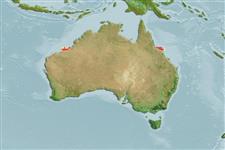>
Blenniiformes (Blennies) >
Blenniidae (Combtooth blennies) > Blenniinae
Etymology: Meiacanthus: Greek, meion = less = lessen + Greek, akantha = thorn (Ref. 45335); luteus: Specific epithet means 'yellow', referring to the brilliant upper body coloration of the species..
Environment: milieu / climate zone / depth range / distribution range
Ecologia
marinhas associadas(os) a recifes; intervalo de profundidade 0 - 35 m (Ref. 7401). Tropical; 19°S - 20°S
Western Pacific: northern Australia, from Western Australia to Queensland.
Tamanho / Peso / Idade
Maturity: Lm ? range ? - ? cm
Max length : 10.3 cm TL macho/indeterminado; (Ref. 2334)
Descrição breve
Morfologia | Morfometria
Espinhos dorsais (total): 4; Raios dorsais moles (total): 26-28; Espinhos anais 2; Raios anais moles: 16 - 18. Males with prolonged pelvic fins and caudal-fin lobes; extending from front of snout through eye and caudal-fin base is a midlateral dark brown to black stripe; another dark brown stripe commencing above eye and passing dorsally on body at base of dorsal fin; head and body between 2 stripes bright yellow, below white (Ref. 27362).
Oviparous. Eggs are demersal and adhesive (Ref. 205), and are attached to the substrate via a filamentous, adhesive pad or pedestal (Ref. 94114). Larvae are planktonic, often found in shallow, coastal waters (Ref. 94114). Poisonous canines provide considerable protection from predators.
Life cycle and mating behavior
Maturidade | Reprodução | Desova | Ovos | Fecundidade | Larvas
Oviparous, distinct pairing (Ref. 205).
Randall, J.E., G.R. Allen and R.C. Steene, 1990. Fishes of the Great Barrier Reef and Coral Sea. University of Hawaii Press, Honolulu, Hawaii. 506 p. (Ref. 2334)
Categoria na Lista Vermelha da IUCN (Ref. 130435)
Warning: mysqli::__construct(): (HY000/1040): Too many connections in /var/www/html/includes/func_getlabel.php on line 46
Can't connect to MySQL database (fbapp). Errorcode: Too many connections
